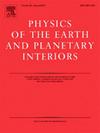数值发电机模拟极性反转过程中的动能传递
IF 1.9
3区 地球科学
Q2 GEOCHEMISTRY & GEOPHYSICS
引用次数: 0
摘要
地球磁场的主导偶极矩几乎平行于地球自转轴。人们普遍认为,地磁场是由地球外核的流体运动维持的,即所谓的发电机作用。古地磁测量表明,地磁场的极性多次逆转。通过地球动力学模拟研究了极性逆转的物理过程,发现极性逆转期间的赤道不对称流比稳定期强。另一方面,由于地球自转的影响,旋转球壳中的对流运动具有等对称流占主导地位的特点。为了研究偶极反转中等对称和反对称流之间的能量传递,我们进行了具有极性反转的地球动力学模拟。相对于平等不对称流的浮力通量,能量传递到平等不对称流的能量传递通常较小。然而,对于极性反转,它以以下方式增加;(1)赤道对称流向磁场传递能量的速率减小;(2)平流向反对称流传递能量的速率增大;(3)浮力向赤道反对称流注入能量的速率增大。目前的结果表明,由切线圆柱内强烈的向上流动引起的强烈的纬向流动可以触发磁场的极性反转。本文章由计算机程序翻译,如有差异,请以英文原文为准。

Kinetic energy transfer during polarity reversals in a numerical dynamo simulation
The Earth has a magnetic field with a dominant dipole moment nearly parallel to the axis of Earth's rotation. It is widely accepted that the geomagnetic field is sustained by fluid motion in the Earth's outer core, the so-called dynamo action. Paleomagnetic measurements have shown that the geomagnetic field has reversed its polarity many times. Some geodynamo simulations have been carried out to investigate the physical process of polarity reversals, and the equatorially antisymmetric flow during polarity reversals is found to be stronger than that during stable periods. On the other hand, convective motions in a rotating spherical shell have characteristics that the equatorially symmetric flow is dominant due to the effect of the Earth's rotation. To investigate energy transfers between the equatorially symmetric and antisymmetric flows in the dipole reversals, we have performed geodynamo simulations with polarity reversals. The energy transfer to the equatorially antisymmetric flow is generally small comparing with the buoyancy flux to the equatorially symmetric flow. Toward a polarity reversal, however, it increases in the following manner; (i) the rate of energy transfer from the equatorially symmetric flow to the magnetic field decreases, (ii) the rate of energy transfer from the equatorially symmetric flow to the antisymmetric flow by the advection increases, and (iii) the energy injection by the buoyancy force into the equatorially antisymmetric flow increases. The present results suggest that the intense zonal flow caused by the intense upward flow inside the tangent cylinder in the either hemisphere can trigger a polarity reversal of the magnetic field.
求助全文
通过发布文献求助,成功后即可免费获取论文全文。
去求助
来源期刊

Physics of the Earth and Planetary Interiors
地学天文-地球化学与地球物理
CiteScore
5.00
自引率
4.30%
发文量
78
审稿时长
18.5 weeks
期刊介绍:
Launched in 1968 to fill the need for an international journal in the field of planetary physics, geodesy and geophysics, Physics of the Earth and Planetary Interiors has now grown to become important reading matter for all geophysicists. It is the only journal to be entirely devoted to the physical and chemical processes of planetary interiors.
Original research papers, review articles, short communications and book reviews are all published on a regular basis; and from time to time special issues of the journal are devoted to the publication of the proceedings of symposia and congresses which the editors feel will be of particular interest to the reader.
 求助内容:
求助内容: 应助结果提醒方式:
应助结果提醒方式:


